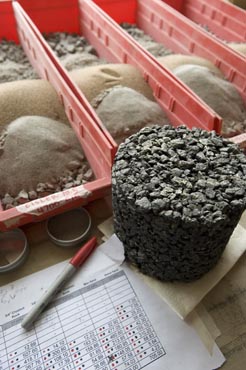Green highways: Research targets environmentally friendly asphalts
For those hoping to create a greener world, our country’s millions of miles of asphalt roads may seem like an odd place to seek solutions. Yet, it’s precisely because asphalt is so common that we have much to gain from making it more eco-friendly, says civil engineering professor Hussain Bahia.

Red bins containing varying mixtures of aggregate, sand and other binder materials used to create asphalt concrete samples are displayed in the Modified Asphalt Research Center. As part of a new national research program called the Asphalt Research Consortium, civil engineering professor Hussain Bahia, who leads the asphalt lab, is now using $5 million in funding to study ways of making asphalt more environmentally sustainable.
Photo: Jeff Miller
As part of a new national research program called the Asphalt Research Consortium (ARC), Bahia is now using $5 million in funding to study ways of making asphalt more environmentally sustainable. UW–Madison is one of only five institutions nationwide to participate in ARC, the Federal Highway Administration‘s first major consortium to improve asphalt technology since the Superpave effort of the early 1990s.
More than 90 percent of U.S. roadways are paved with asphalt, which means any modifications that boost its recycled content, lengthen its life, or cut the energy needed to manufacture it could have a big impact on the environment and our pocketbooks, says Bahia. One of his first goals is to develop so-called "cold mix" asphalts for widespread introduction into the United States. Places like Africa and India have used them for decades, and research shows they can save up to seven times the energy of their hot mix counterparts.
"This is a no-brainer," says Bahia, who has studied asphalt for more than 20 years. "If any person involved in managing our infrastructure looks at the data, why would you spend more energy and money on something else? But the challenge will be to show through advanced design of these materials that the performance is equal."
Asphalt is a byproduct of oil refining; essentially, it’s the black, sticky stuff that remains after fuel and lubricating oil are extracted from crude petroleum. It’s too thick, however, to be laid on roads as is. That’s why in places like the United States and Europe, it’s first heated to temperatures as high as 300 degrees Fahrenheit, making it easy to pump and apply.
“[Using ‘cold-mix’ asphalt] is a no-brainer. If any person involved in managing our infrastructure looks at the data, why would you spend more energy and money on something else? But the challenge will be to show through advanced design of these materials that the performance is equal.”
Hussain Bahia, professor of civil engineering
Other parts of the world have taken a very different approach. In South Africa, for example, asphalt is made workable by shearing it into fine particles, and then mixing it with water and soap-like chemicals called surfactants. The surfactants keep the asphalt in solution until it’s laid, after which it hardens to form the road surface.
Studies by Canada’s Office of Energy Efficiency and others have found that paving with these cold mixes (also called emulsions) saves significant amounts of energy, especially when combined with recycling efforts. These asphalts also cut emissions of carbon dioxide and other gases. But a number of issues remain, and this is where Bahia hopes his research will make a difference.
"At U.S. refineries today, there are very mature, established specifications for hot binders — our paving grade asphalts," he says. "But for emulsions, there is no clear agreement on how to define the quality. So, we have emulsions already, but we don’t produce them as much because the specifications aren’t as clear."
Realizing that his own knowledge was incomplete, Bahia traveled during his sabbatical last year to South Africa — a hot bed for cold mix research — and returned brimming with ideas for advancing the technology even further. Eventually he’d like to experiment with adding materials to cold mixes, such as polymers or plastics, which can make pavements quieter, safer and more durable. In fact, these "modified" asphalts are the major thrust of a new campus center he’s establishing called the Modified Asphalt Research Center (MARC).
But before embarking on those studies, Bahia first wants to develop quality control tests and standards that will encourage U.S. engineers, chemists and road builders to adopt cold mix asphalts, or at least give them a try. This means first defining the critical ways in which these asphalts fail, and designing systems for detecting the failures.
"We can then determine the chemistry or physics that will give us a larger margin of safety from these failures," says Bahia. The final step will involve simulating various climate conditions in the laboratory to see how failure limits change with freezing cold or blazing heat.
But if green asphalts hold such promise, why haven’t these standards been worked out here before? In short, we haven’t had to, Bahia says. Until now, we’ve gotten away with using more expensive and energy consuming hot mixes because of our wealth of resources. Meanwhile, countries such as South Africa and India haven’t had the same resources at their disposal.
"In South Africa, they initially decided to go with the low-energy approach because it can save a lot of money," says Bahia. "Then as their economy grew, they had to build high-performance roads. But instead of switching to hot mixes, they improved their knowledge to build better cold mixes."
Now, as concerns about energy and climate change continue to mount, these asphalts are starting to spread beyond the developing world. Paris, France, recently mandated that all new roads be built with lower temperature mixes for environmental reasons. And in North America, there have been many trials with warm mixes that are a step between hot and cold. It gives Bahia hope that the United States will eventually adopt the technology, too.
"Why are we spending so much money on something else? I think there’s a very good reason: lack of sufficient knowledge," he says. "And our job as a university is to provide the knowledge that will hopefully one day get us there."


